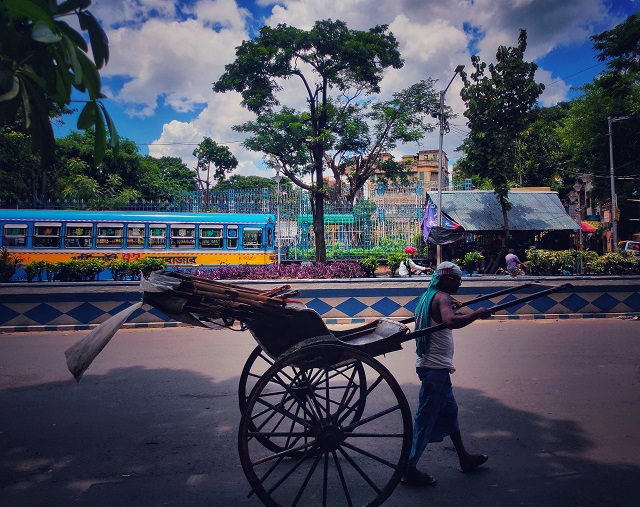Kolkata is a city full of paradoxes. It was the first city in India to build a metro rail system, and it is currently the only city in the world that still uses authorised hand-pulled rickshaws, or tana rickshaws as they are known in Bengali, as a form of public transportation. The All-Bengal Rickshaw Union estimates that there are currently more than 14,000 unlicensed and more than 5,000 licenced rickshaws in use in Kolkata.
The Japanese word "Jin-riki-sha" is the source of the English word "rickshaw" (jin meaning human, riki meaning power, and sha meaning vehicle; which translates to human-powered vehicle). However, the palki was a type of human-powered vehicle that existed earlier in India (palanquin). The palki was a covered litter that was carried by four carriers on shoulders, unlike the rickshaw.
The palki was an effective mode of personal transportation in the past when India had few paved roads because it had no wheels. In the eighteenth and nineteenth centuries, a sizable immigrant population of Biharis and Odiyas worked as palki bearers in British Calcutta. In a sense, today's rickshaw pullers were ancestors of these palki bearers. With the introduction of horse-drawn buggies, bicycles, hand-pulled rickshaws, trams, trains, and other mechanised public transportation methods, palkis' appeal waned.
Invented in Japan in 1869, the hand-pulled rickshaw was first made available in China in 1874.
The rickshaw had the important advantage of being driven by a single person, in contrast to earlier modes of transportation like the kago, sedan chairs, etc. which required two persons to carry. In the ensuing decades, hand-pulled rickshaws experienced a boom in Japan, China, Singapore, India, Indonesia, and Malaysia. They gave millions of disadvantaged working-class families living in cities access to affordable transportation options and jobs.
The growth of public transportation in the city was greatly aided by Calcutta's dominant status as the capital of British India.
These newcomers brought the rickshaw to Calcutta after coming from British territories like Canton, Shanghai, and Hong Kong. Shimla, the summer capital of the British Raj, had already adopted the hand-pulled rickshaw a few decades earlier, but due to the mountainous terrain there, its use was still rather restricted. The British passed the Hackney Carriage Act in 1919, allowing hand-pulled rickshaws to be rented as a means of passenger transportation in Calcutta.
The use of one human to pull another human contributed to reinforce the master-slave power structure when the British were the predominant colonial power in Asia. After World War II, colonialism in Asia began to weaken, and hand-pulled rickshaws started to disappear from use in former British territories. Strangely, rickshaws' legacy persisted in Calcutta long after the British Empire had collapsed (1947) and the communist government of China had outlawed their use (1949). The resilient hand-pulled rickshaw not only survived in Calcutta, but it also rose to fame as a symbol of the city.
The manual crank There are a variety of socioeconomic factors specific to Kolkata that allow rickshaws to survive. First off, pushing a rickshaw demands hard physical labour rather than talent. In Kolkata, unskilled labourers who are unemployed work as rickshaw pullers. They do not need to be trained or have a licence to operate. The majority of rickshaw drivers are not even familiar with the names of the roads they travel on or the meanings of the various traffic signs. This is due to the fact that they speak Hindi rather than the native Bengali and are largely illiterate. Many rickshaw drivers rent their khatals from sardars (rickshaw owners), who do not even own the vehicles themselves (rickshaw garages).
In addition, urban planning has contributed to the survival of this method of transportation. Low-lying neighbourhoods' roadways frequently flood as a result of poor drainage. The hand-pulled rickshaw is the only mode of transportation that can travel over flooded streets during severe monsoons. Its independence from fossil fuels makes it more affordable and environmentally friendly, and its small size makes it simple to manoeuvre through Kolkata's winding lanes.
Today, rickshaw drivers make a meagre wage and live largely on the streets, saving every rupee to send home to their family as a result of diminishing popularity and the accessibility of other forms of transportation. Sardars must also pay for their food and housing on top of this, which leaves them with very little left over for their own needs.
Numerous people abuse alcohol and experience numerous illnesses and health issues linked to ageing and the physical demands of work.
Due to the presence of this colonial artefact, Kolkata has received a lot of criticism. The Calcutta Hackney-Carriage (Amendment) Bill, passed by the state legislature in 2006, was an attempt to permanently outlaw these rickshaws, but it was never put into effect. After the change of government in 2011, pledges to replace the authorised hand-pulled rickshaws with electric or cycle rickshaws were made, but nothing has happened. If these rickshaws to be permanently removed from the streets, a viable solution must be developed to guarantee adequate rehabilitation for all those involved in the enterprise, both directly and indirectly.
By-
Sriparna Mukherjee
Amity University, Kolkata


Comments
Post a Comment